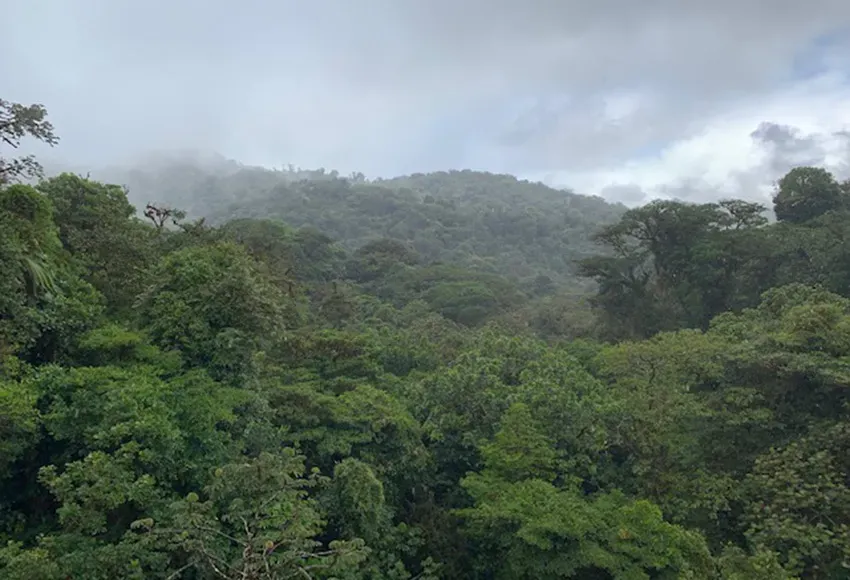When Christopher Columbus made his fourth trip across the Atlantic, it brought him to what is now the small country of Costa Rica. While refitting his ship there, the Indigenous people presented him with gifts. Among them was gold, hence the name (meaning "rich coast") was born.
Not surprisingly, Costa Rica lives up to the name still today, as one of the most biodiverse countries in the world. It is home to more than 500,000 plant, animal, and insect species, representing 4% of the world's flora and fauna.
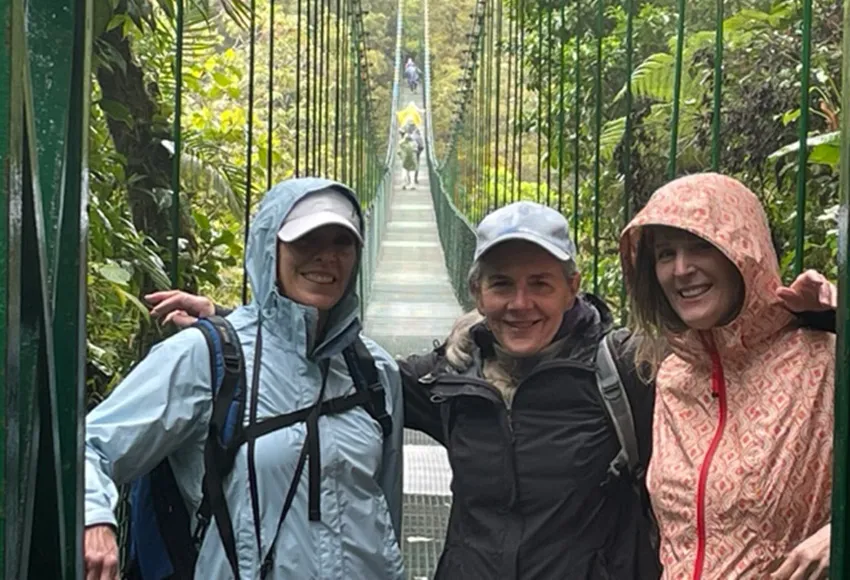
An opportunity
A friend of mine had purchased a condominium in the northwestern Guanacaste region, so she benevolently invited me and another mom to accompany her on a trip there. We excitedly booked our tickets and jetted off, sans family! Alaska Air flew us directly from Los Angeles to Liberia, Costa Rica, in just over five hours.
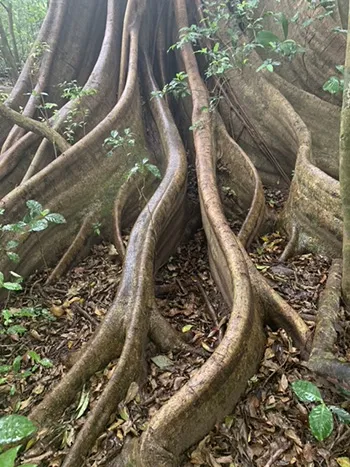
Hiking
Costa Rica offers many hiking opportunities. We chose a six-mile-round-trip, intermediate hike in the Rincón de la Vieja National Park. Our destination was Catarata La Cangreja, a tall and stately waterfall with a crystal aqua pool at its base that welcomed us. We encountered nature's mix of huge boulders, natural rock steps, and buttress tree roots reminiscent of the artificial terrain at a Disney park. Breathing the wet, earthy air felt like the cleanest oxygen on earth.
When we were heading out, it occurred to us that the only thing missing from our hike was a monkey sighting. We were told by other hikers that there was a group of 50 monkeys, but we had seen no sign of them. But Rincón de la Vieja did not disappoint! The trees started shaking, and we spied flashes of black movement. It was a family of capuchin monkeys! These little, white-faced monkeys, often seen in movies wearing red button-up jackets and wreaking havoc, noticed us too. Green nuts and small branches began dropping close to our heads. Were they sending us a message? Yes: they are extremely territorial. This was a riveting performance, but their quick movements evaded our cameras.
Beaches
Bordered by oceans on both coasts, Costa Rica offers a large variety of beaches. Within the small region we visited, we were able to visit a number of them.
Playa Conchal (Shell Beach) warmly received us. This one is unique because the sand is made from crushed shells (thus the name). The waves were in rare form on this day, sneaking up and trying to roll us. In the end, the slope of the beach and power of the waves were too much. In our struggle to stay standing up, we provided some comedic entertainment for the onlooking beachgoers!
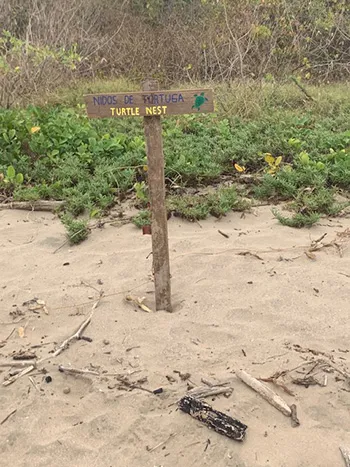
Playa Grande (Big Beach) is world-renowned for its leatherback turtle nesting sites. From January through the end of February, the hatchlings break out of their shells and scurry down the beach under the cloak of darkness. To protect this endangered species, their nests are marked by signs and patrolled by the park rangers, and buildings lining the beach are not allowed to turn on lighting on the ocean side of their property (if the hatchlings see light, they move toward it and will not make it to the sea). We also encountered a "do not feed the crocodiles" sign, as crocs inhabit the estuary near Playa Grande. Fortunately, we did not spot one on this trip.
Playa Avellana is a great spot for surfing and boogie boarding. We tried our hand at some rookie boarding. The waves were perfect – until a strong one washed away two pairs of sunglasses and poured sand into our bathing suits. Nothing brings you back your childhood like being mishandled by the ocean through body surfing and boogie boarding.
Excursions
We booked two excursions through Natives Way tour company (https://www.nativeswaycostarica.com/), which was recommended by our hostess, who has tried many of its offerings.
Our first adventure was a walk in the clouds in Monteverde Cloud Park, which began by crossing eight hanging bridges above the forest. Jaw-dropping beauty akin to something you'd see in movies created a feast for the eyes. Bromeliads, which we know as indoor plants, were prolific, providing a rain catch for the frogs to lay their eggs in. Many nature documentaries are filmed here, not surprisingly.
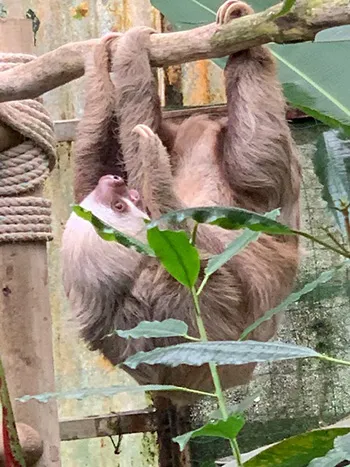
Off to visit the true celebrities of CR: the sloths. The sanctuary at Monteverde has taken in 17 two-fingered sloths, originally rescued as babies that fell from trees and would not have survived if left to their own devices. Did you realize they can actually move fast? When a female is in heat, the male gets his hustle on. Once he's reached her, they participate in a 35-second interlude, and baby is on the way!
Next, we viewed the reptile display, which exhibited primarily snakes, a few frogs, and the Jesus Christ lizard, so named because it walks on water. Costa Rica boasts 35 species of poisonous snakes, not to mention those vividly colored, teeny-tiny poison dart frogs. A day at Monteverde is well spent!
For our second full-day excursion, we visited Guachipelin Adventure Park. We began our tour by rafting down five kilometers of the Negro River. As fortune had it, there was a large crew of assistants waiting on the boulders ready to push, veer, and direct us through the rough parts. This hour-and-a-half journey conjured terrifying and exhilarating feelings simultaneously.
Zip-lining over the dry forest and impressive slot canyons was our next activity. Apparently, there were eight different zip lines, but truthfully, I lost count after the Tarzan swing, which was traumatic.
The horseback riding portion was as expected. We were a tourist parade on mellow horses, who knew the route and fought for placement. However, we did spy a green iguana in the brush!
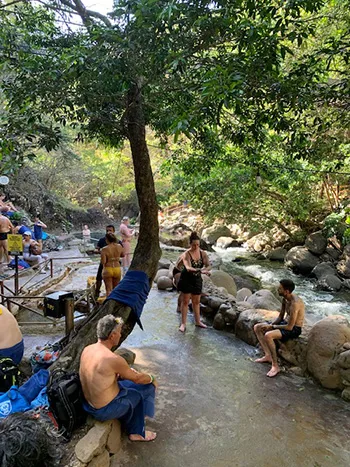
Ending the day (yes, that was one day) at the 10 natural hot springs pools – which ranged from 36 to 40 degrees Celsius – was rewarding. Before dipping into them, we enjoyed a volcanic clay mud bath. Ahhhh, what a way to end the day!
Food
For dinner with sunset, Coco Loco at the south end of Playa Flamingo is the place. The drink of the same name is served in a young coconut, with a straw, like on Gilligan's Island. For dinner, the parrotfish ceviche with lime, corn, and avocado was a fresh, healthy, and satisfying entree. Ending the meal perfectly with coconut ice cream in a half coconut shell embedded with lush fresh coconut brought a smile.
Patagonia del Mar near Playa Brasilito has a menu that will please everyone. The atmosphere is dreamy, and the pool on the property means you can take a swim while you wait for your food. I ordered the tuna poke bowl, which was seriously divine!
Pots and Bowls near Playa Grande is a quaint, casual open-air café. It offered coconut pancakes, poke, vegetarian options, and baked goods. Everything on the menu looked enticing!
If you are looking for an authentic experience, frequenting a soda is a must. These are small, family-owned-and-run restaurants patronized by locals. You will find the comida típica (typical dish) of casado served at these establishments – it features white rice, beans, meat (such as chicken, beef, or fish), and a salad, typically served with fresh pico de gallo and plantains.
The Costa Rican people are proud of their biodiverse country, and they are dedicated to the protection of their fragile and rich environment. If you visit here, you'll see why. Life there is simple and pure – as the ticos (native Costa Ricans) say, "¡Pura vida!"
For more information on tours in Costa Rica, visit https://www.nativeswaycostarica.com/.


